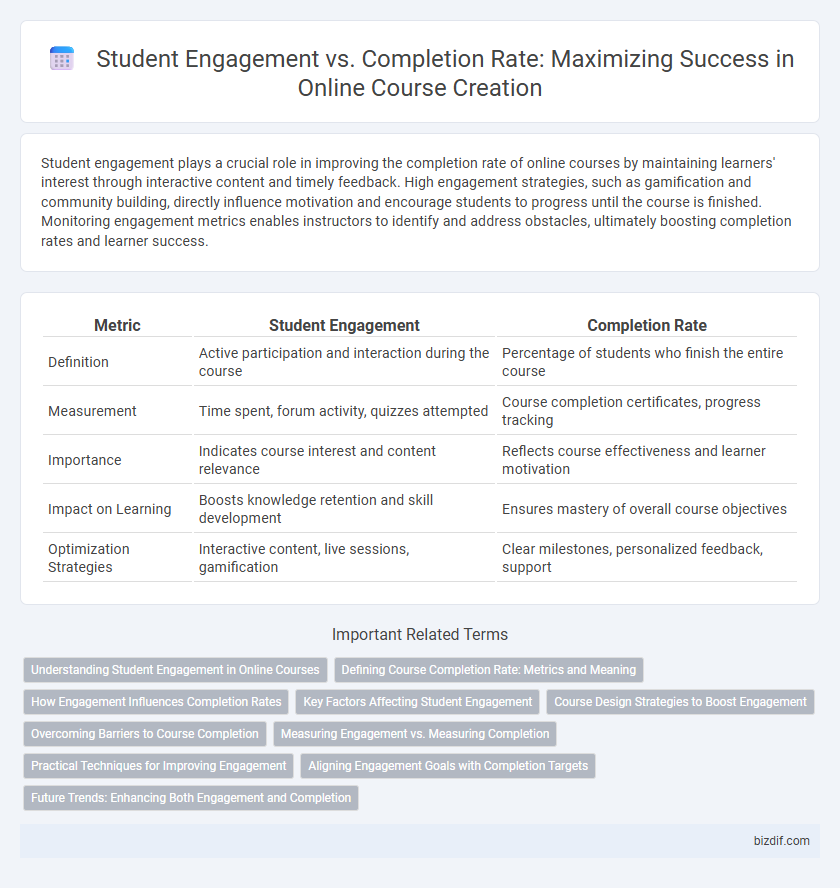Student engagement plays a crucial role in improving the completion rate of online courses by maintaining learners' interest through interactive content and timely feedback. High engagement strategies, such as gamification and community building, directly influence motivation and encourage students to progress until the course is finished. Monitoring engagement metrics enables instructors to identify and address obstacles, ultimately boosting completion rates and learner success.
Table of Comparison
| Metric | Student Engagement | Completion Rate |
|---|---|---|
| Definition | Active participation and interaction during the course | Percentage of students who finish the entire course |
| Measurement | Time spent, forum activity, quizzes attempted | Course completion certificates, progress tracking |
| Importance | Indicates course interest and content relevance | Reflects course effectiveness and learner motivation |
| Impact on Learning | Boosts knowledge retention and skill development | Ensures mastery of overall course objectives |
| Optimization Strategies | Interactive content, live sessions, gamification | Clear milestones, personalized feedback, support |
Understanding Student Engagement in Online Courses
Student engagement in online courses significantly influences completion rates by fostering active participation and deeper learning experiences. Key factors such as interactive content, timely feedback, and community interaction enhance engagement, which directly correlates with higher course completion. Tracking metrics like time spent on modules, quiz participation, and discussion involvement provides insights to optimize course design for improved student retention.
Defining Course Completion Rate: Metrics and Meaning
Course completion rate measures the percentage of students who finish an online course relative to those who enrolled, indicating overall learner commitment and course effectiveness. Key metrics include progress tracking, assessment scores, and time spent on modules, which provide insights into engagement levels and identify potential drop-off points. Understanding completion rate helps educators optimize content, improve student motivation, and enhance course design for better learning outcomes.
How Engagement Influences Completion Rates
Higher student engagement in online courses directly boosts completion rates by fostering active participation and sustained interest. Interactive content, regular assessments, and timely feedback enhance engagement levels, encouraging learners to persist through course material. Courses designed with engagement strategies see significantly improved learner retention and successful course completions.
Key Factors Affecting Student Engagement
Student engagement in online course creation significantly influences completion rate, with interactive content, timely feedback, and personalized learning paths being critical factors. Incorporating multimedia elements such as videos, quizzes, and discussion forums enhances active participation and reduces dropout rates. Consistent instructor presence and clear course structure further motivate learners to stay committed and achieve successful course completion.
Course Design Strategies to Boost Engagement
Effective course design strategies play a crucial role in enhancing student engagement and improving completion rates in online courses. Incorporating interactive elements such as quizzes, multimedia content, and discussion forums fosters active learning and sustained interest. Clear learning objectives, modular content structure, and timely feedback contribute significantly to maintaining motivation and reducing dropout rates.
Overcoming Barriers to Course Completion
Low student engagement often correlates with reduced course completion rates in online courses, highlighting the need to identify and overcome barriers such as lack of motivation, limited interaction, and unclear learning paths. Implementing interactive elements, personalized feedback, and flexible pacing can significantly enhance learner commitment and progress. Data-driven insights from learner analytics help educators tailor interventions that reduce dropout rates and boost overall course effectiveness.
Measuring Engagement vs. Measuring Completion
Measuring student engagement in online course creation involves tracking metrics such as time spent on content, interaction frequency, and participation in discussions, which provide insights into learner involvement. Completion rate, however, measures the percentage of students who finish the entire course, offering a clear indicator of course effectiveness but not the depth of engagement. Combining engagement metrics with completion rates delivers a comprehensive understanding of both learner activity and course success.
Practical Techniques for Improving Engagement
Boosting student engagement in online courses directly enhances completion rates by fostering active participation and sustained interest. Implementing interactive elements such as quizzes, discussion forums, and real-time feedback encourages learners to stay connected with the material. Utilizing gamification strategies and personalized learning paths further motivates students to progress through the course, improving overall completion outcomes.
Aligning Engagement Goals with Completion Targets
Aligning student engagement goals with completion rate targets requires designing interactive content that motivates learners to progress continuously. Tracking metrics such as time spent on modules, quiz participation, and discussion contributions helps identify engagement patterns that predict completion likelihood. Optimizing course elements based on these insights fosters higher retention, ensuring engagement strategies directly contribute to successful course completion.
Future Trends: Enhancing Both Engagement and Completion
Emerging technologies such as AI-driven personalized learning and immersive virtual reality environments are transforming online course creation to boost both student engagement and completion rates. Adaptive learning platforms analyze individual progress, providing customized content that maintains motivation and reduces dropout rates. Gamification and real-time feedback mechanisms further enhance interactive experiences, driving sustained commitment and higher course completion in the evolving e-learning landscape.
Student Engagement vs Completion Rate Infographic

 bizdif.com
bizdif.com